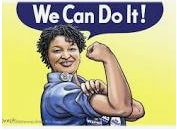from Newsweek,
9/24/21:
In hindsight, the biggest warning sign for the prospects of unionizing Amazon's Bessemer, Alabama, warehouse was, well, a sign: a large placard, posted by organizers outside the facility's entrance, featuring Stacey Abrams dressed as Rosie the Riveter, declaring "We Can Do It!" through a COVID mask.
 Adopting the failed gubernatorial candidate and progressive darling as the symbolic heroine of the campaign was part of an effort to link unionization to progressive causes—voting rights, racial justice and gender equity—that organizers thought would appeal to a predominantly Black workforce.
"Stacey the Riveter" may have been a hit with Democratic politicians, who posed for pictures with the sign on visits to the facility. But not so much with the workers themselves. Abrams lost her election by 2 points; the union lost its by more than 30.
Adopting the failed gubernatorial candidate and progressive darling as the symbolic heroine of the campaign was part of an effort to link unionization to progressive causes—voting rights, racial justice and gender equity—that organizers thought would appeal to a predominantly Black workforce.
"Stacey the Riveter" may have been a hit with Democratic politicians, who posed for pictures with the sign on visits to the facility. But not so much with the workers themselves. Abrams lost her election by 2 points; the union lost its by more than 30.
This "intersectionality" of labor issues and virtually every progressive social cause has become a defining feature of union activism. United Steelworkers, for instance, has "encourage[d] all local unions to initiate LGBTQ+ activism" led by its Steel Pride affiliate organization. Labor leaders from the SEIU and other national labor unions, meanwhile, have formed the Labor for Equality Council to promote the Equality Act because "LGBTQ rights and labor rights are intrinsically linked." Labor reformers have fallen prey, too. Harvard University's "Clean Slate for Worker Power," for instance, maintains that its blueprint for redesigning labor law "must start with inclusion" and "address systemic racial and gender oppression."

The year before, then-AFL-CIO president, Richard Trumka, pledged that organized labor would "be an ally" of the LGBTQ community and Black Lives Matter by "invest[ing] in Black transgender leadership" and "electing candidates...who understand the intersectionality of worker and LGBTQ rights."
More From Newsweek:





